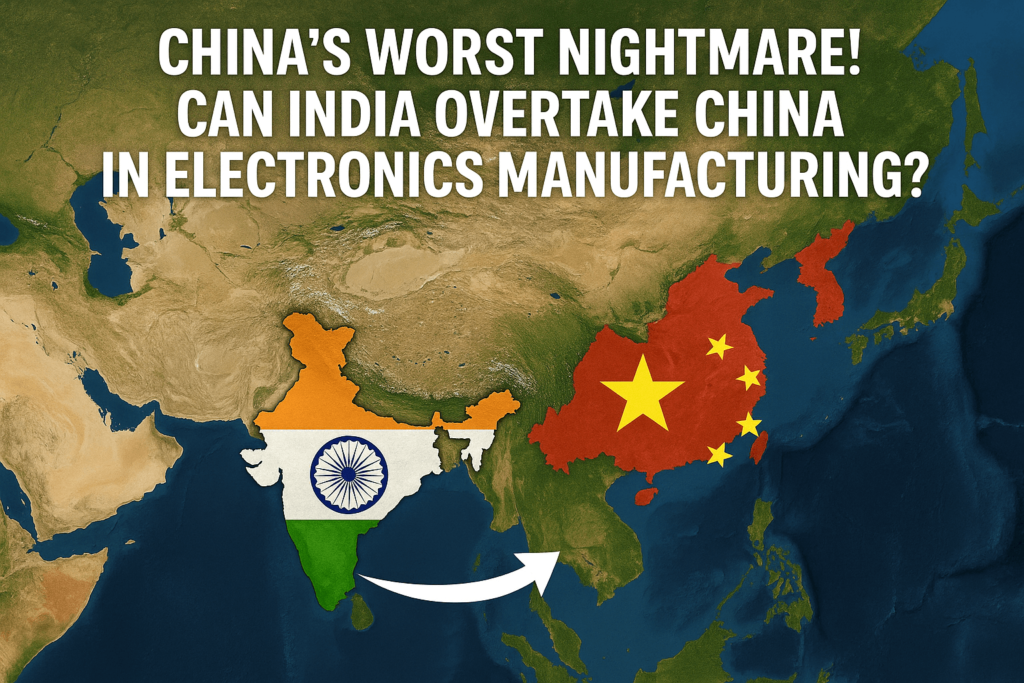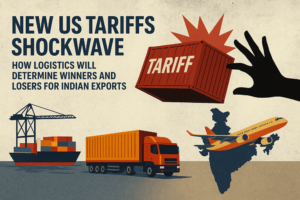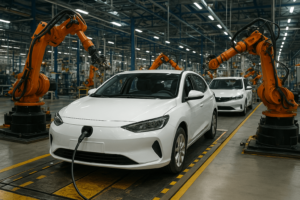
India’s electronics manufacturing sector is on the brink of transformation. With Foxconn’s $1.5 billion investment, Tata Group’s semiconductor foray, and over $8 billion in new electronics commitments, India is gearing up to be a global electronics superpower—not just an assembly base.
But can it really take on China? Let’s explore India’s momentum, opportunities, and the challenges that could define its next decade in the global supply chain.
From Assembler to Electronics Powerhouse
India’s electronics sector has made giant strides in the past five years:
- 📈 Electronics exports rose from $6 billion in 2017 to $23 billion in FY 2023-24
- 📱 India is now the world’s second-largest smartphone manufacturer
- 🇮🇳 India is expected to hit $300 billion in electronics output by 2026, with exports comprising nearly 50%
With 500+ million smartphone users, a massive domestic market, and a growing global footprint (India now exports smartphones to 70+ countries, including the UK and Germany), the country is no longer just playing catch-up—it’s building dominance.
Who’s Investing and Why?
🔧 Foxconn’s Big Bet
Foxconn, the global assembler of iPhones, is investing $1.5 billion in India—not just for assembly, but to create an ecosystem of high-value manufacturing. The plant is part of a broader shift as global players de-risk from China.
🧠 Tata’s Semiconductor Play
Tata Group is entering semiconductor manufacturing, aiming to build India’s first indigenous fab—critical to reducing import dependence on chips.
💰 The Government Push: PLI Scheme
India’s Production-Linked Incentive (PLI) scheme has injected billions to boost local electronics production. Companies like Samsung, Dell, and Dixon Technologies are expanding operations as a result.
What’s Fueling India’s Electronics Rise?
- 📍 Strategic Location: Proximity to Southeast Asia, Middle East, and Europe makes India a preferred supply chain hub.
- 👩💻 Young Workforce: A massive, tech-savvy labor force brings cost and innovation advantages.
- 🚚 Growing Infrastructure: Projects like Gati Shakti, Dedicated Freight Corridors (DFCs), and Industrial Corridors (e.g., Chennai–Bengaluru) are improving logistics.
But It’s Not All Smooth Sailing
India’s ascent faces some critical bottlenecks:
🧩 1. Import Dependency on Components
Over 75–80% of components like:
- Semiconductors
- Displays
- Batteries
…still come from China or Taiwan, making India vulnerable to geopolitical disruptions.
🚧 2. Infrastructure Gaps
- Port congestion
- Unreliable power supply
- Last-mile delivery delays
These can increase turnaround time and raise production costs.
📉 3. Skills Gap
While India has talent, mid-level technical skills—especially in microelectronics, robotics, and QA—need rapid upskilling to support complex manufacturing.
🏭 4. Weak Component Ecosystem
Local industries for:
- PCBs
- Microchips
- Connectors
- Specialized packaging
…are underdeveloped, limiting vertical integration and slowing innovation.
What India Needs to Dominate the Electronics Map
✅ Build a Local Supply Chain
- Incentivize chip fabs, battery manufacturing, and component vendors
- Reduce reliance on imports by attracting Tier 2 and 3 suppliers
✅ World-Class Logistics
- Expand multi-modal corridors and dedicated freight systems
- Improve port digitization and customs turnaround
✅ Scale Skill Development
- Launch global-standard certification programs
- Collaborate with firms like Foxconn and Intel to upskill in microelectronics and robotics
✅ Rebrand Globally
- Shift perception from “low-cost assembler” to “high-tech manufacturer”
- Promote Indian innovation in design, automation, and IoT integration
Quick Facts That Might Surprise You
- 🇮🇳 India produced more smartphones in 2024 than the entire European Union
- 📍 Samsung’s Noida factory is the world’s largest single-location smartphone plant
- 🌎 India exports smartphones to over 70 countries, including the UK, UAE, and Germany
Is India Really China’s Biggest Threat in Electronics?
India’s momentum is undeniable. From record investments to government-backed incentives and an eager workforce, the nation is laying the groundwork for long-term leadership in the global electronics market.
But to truly rival China, India must move beyond assembly and create a resilient, end-to-end electronics ecosystem—from chips to chargers, from design to delivery. #IndiaElectronicsManufacturing #FoxconnIndia #PLIelectronics #SemiconductorIndia #SmartphoneExports #IndiaVsChina #MakeInIndia #ElectronicsSupplyChain #NoidaFactory #TechManufacturingIndia











